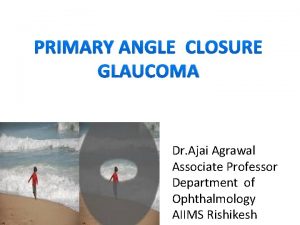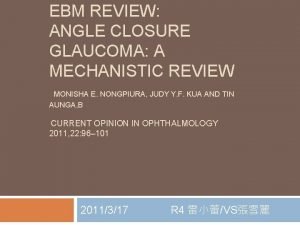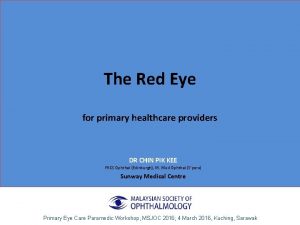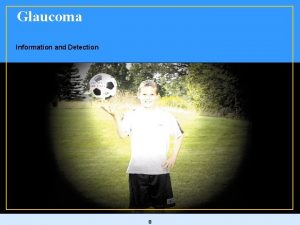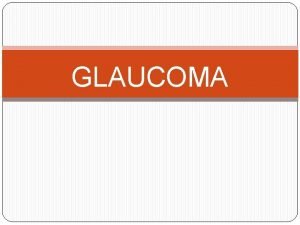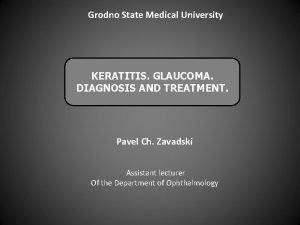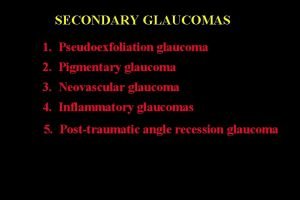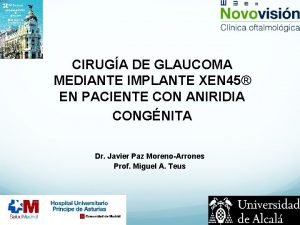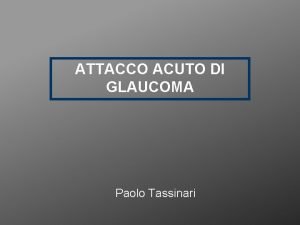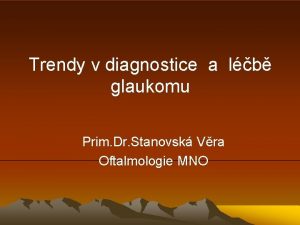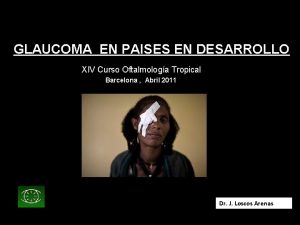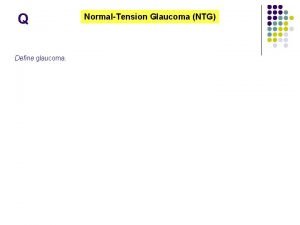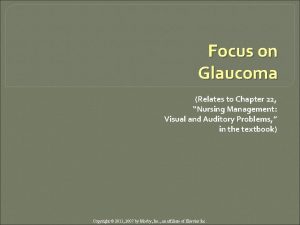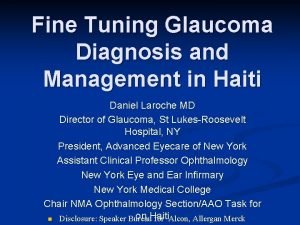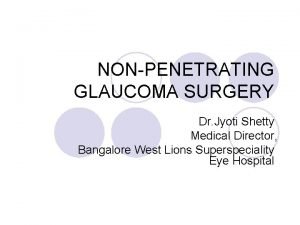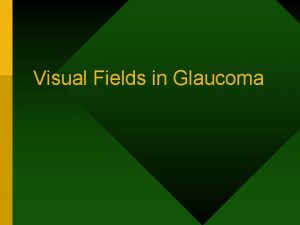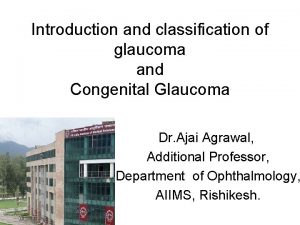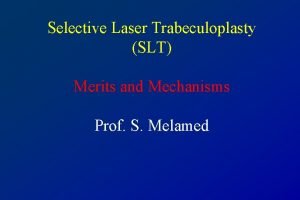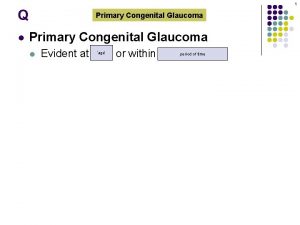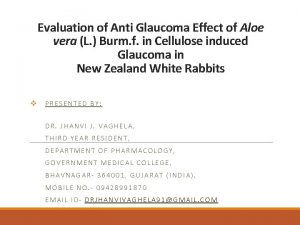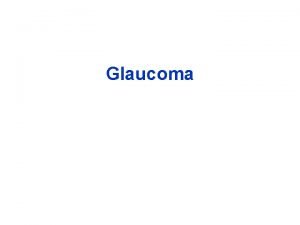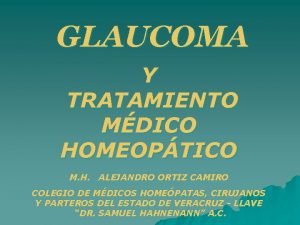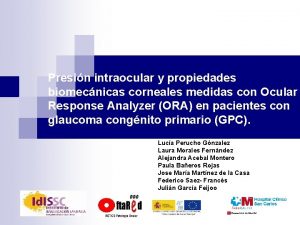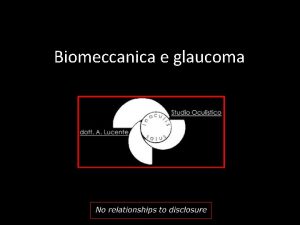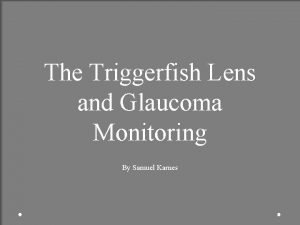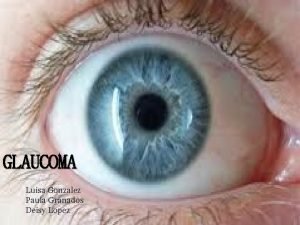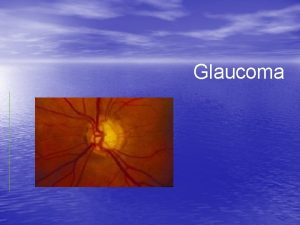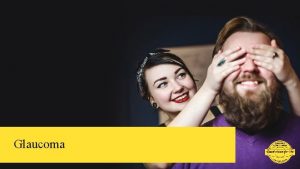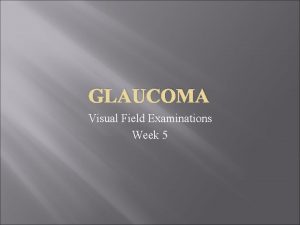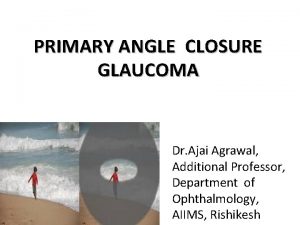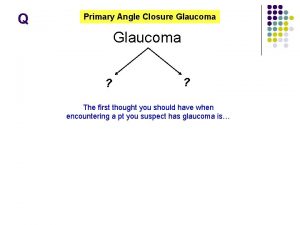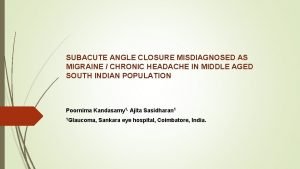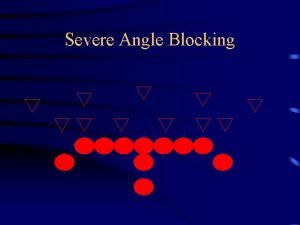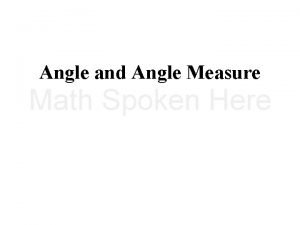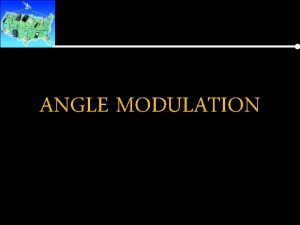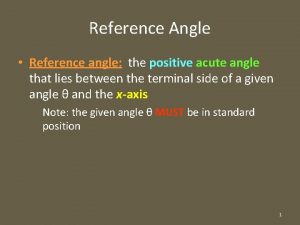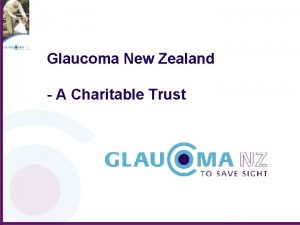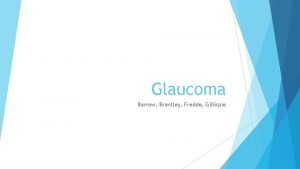Chronic Angle Closure Glaucoma Judith Simon MD Dept

































- Slides: 33

Chronic Angle Closure Glaucoma Judith Simon MD Dept. of Surgery, TTH

TTH Eye Clinic

Primary Angle Closure Glaucoma • AACG – Acute Angle Closure Glaucoma • CACG – Chronic Angle Closure Glaucoma • CACG is much more common • CACG can progress to AACG if not treated

• • • Pathophysiology Symptoms Diagnosis Treatment – recent paradigm shift Case study

POAG vs PACG • PACG is about 25% of all glaucomas • Estimated 5. 9 mil vs 5. 3 mil blind by 2020 How is this possible? ? ?

POAG vs PACG • Risk of blindness is 3 x greater in PACG! • Prevalence of PACG is 2 -4 x more common in West than previously reported • Reason? ?

Pathophysiology of PACG • Pupillary block mechanism • Non-pupillary block mechanism – Plateau iris – Thick lens – Ciliary block


Non-pupillary block • As lots of PTs (60 -80%) still have IOP rise after dilation even after LPI, there must be other mechanisms responsible too

Plateau iris

Normal angle

Narrow angle with thick lens pushing iris forward

Symptoms of CACG • Usually none until severe damage • PT can have halos around light/headache/blurry vision episodically

Diagnosis • First we MUST THINK ABOUT IT so we could notice it!!! • Shallow AC – suspect PACG • Deep AC and high IOP – suspect PACG

ACD Grading by Pentorch

AC Grading by Van Herrick method

AC Grading by Van Herrick method

Suspicion of CACG • Very high IOP (>40) in the absence of secondary causes • IOPs fluctuate greatly from one visit to next on treatment • Disc damage with NL IOPs (might be misdiagnosed as NTG) • IOP significantly greater after dilation • Minimal or no response to glau drops

Gonioscopy • • The gold standard of evaluating the angle MUST learn, practice and TEACH!!! Motivated eye nurses can also learn Every glaucoma patient should have it yearly !!!

Sussmann lens – no goniosol, can do indentation gonioscopy

3 -mirror lens – better view, requires goniosol

Normal open angle

Narrow or closed angle

More on gonioscopy • The only way to learn it is to DO IT!!! • Must see a lot of normal angles to be able to tell pathology • Always check both eyes • Quite difficult to learn, do not get discouraged!

Treatment • • • Pilocarpine drops Laser iridectomy Surgical iridectomy Cataract extraction Clear lens extraction

Laser iridectomy • Prophylactic – Prevents ONLY AACG – In PTs who have narrow angles but asymptomatic – In PTs with other eye AACG – In PTs with CACG • Therapeutic – For AACG – NOT In CACG, IOP decreases in only 40% or less of patients

Laser iridectomy

YAG LASER IRIDECTOMY INFORMATION • • • You have a condition called angle closure glaucoma in both of your eyes. This causes very high eye pressures. The high eye pressure can kill your optic nerve, the wire connecting your eye to your brain, and your vision might be lost forever. You need a laser treatment to PREVENT your eyes from going blind. You will NOT be able to see better after the laser. Your vision will become blurry for a few days and then return to what it was. If you already lost vision from glaucoma, it will not return, the laser just prevents your eyes from getting worse. We will do the laser only on one eye, and in one or two weeks we will do it on the other eye. • • The procedure lasts only for a few minutes and you might have small pain. It costs 20 Gh. C. Your will need to use eyedrops for 2 weeks and need to come for follow-up. Please let us know if you have any questions. •

EAGLE Study • Effectiveness of Angle closure Glaucoma treatment with Lens Extraction • 419 Pts, >age 50, IOP>30, no cataract • Half clear lens extraction, other half LPI + medical therapy • 3 year follow-up

Results Clear Lens Extr LI + drops Drops needed 0. 4 1. 3 IOP 1. 2 mm. Hg lower Vision 3 ETDRS letter better Additional surgery < 0. 5% Cost Cheaper QOL Better 9%

Lens extraction in Ghana • If PT has a cataract, do it! (>6/24) • If access to phaco, can do it with clear lens • In advanced cases beware of snuffout – no retrobulbar/pressure on globe, give Diamox postop

Case study • • 65 yo F VR 6/24, VL HM IOPs 35/46 CDR 0. 9/1. 0 VF advanced gl defect OD SICS done OD VR 6/12 2 m later, IOP 15 without drops

Conclusion • Always think of chronic angle closure when seeing glaucoma patients! • Do gonioscopy! • Remove lens as primary treatment, or if vision is very good, do Laser Iridectomy!
 Angle closure glaucoma
Angle closure glaucoma Primary angle closure glaucoma
Primary angle closure glaucoma Dr chin pik kee
Dr chin pik kee Open angle glaucoma risk factors
Open angle glaucoma risk factors Pathophysiology of glucoma
Pathophysiology of glucoma Site:slidetodoc.com
Site:slidetodoc.com Nursing care nursing management of cataract
Nursing care nursing management of cataract Bayoneting vessels glaucoma
Bayoneting vessels glaucoma Congenital glaucoma
Congenital glaucoma Pseudoexfoliation glaucoma
Pseudoexfoliation glaucoma Piomes
Piomes Blocco pupillare
Blocco pupillare Pex glaucoma
Pex glaucoma Iridenclesis
Iridenclesis Scheie stripe
Scheie stripe Nursing assessment for glaucoma
Nursing assessment for glaucoma Notch glaucoma
Notch glaucoma Pseudoexfoliation glaucoma
Pseudoexfoliation glaucoma Non penetrating glaucoma surgery
Non penetrating glaucoma surgery Baring of blind spot in glaucoma
Baring of blind spot in glaucoma Congenital glaucoma classification
Congenital glaucoma classification Slt vs alt
Slt vs alt Glaucoma continuum
Glaucoma continuum Haab's striae
Haab's striae Is aloe vera good for glaucoma
Is aloe vera good for glaucoma Springbank glaucoma
Springbank glaucoma Glaucoma anatomy
Glaucoma anatomy Dot
Dot Capsulatomy
Capsulatomy Drenaje humor acuoso
Drenaje humor acuoso Glaucoma congenito
Glaucoma congenito Glaucoma phacomorphic
Glaucoma phacomorphic Triggerfish lens
Triggerfish lens Anillo neurorretiniano
Anillo neurorretiniano
